|
|
 |
|
Calanoida ( Order ) |
|
|
|
Calanoidea ( Superfamily ) |
|
|
|
Paracalanidae ( Family ) |
|
|
|
Acrocalanus ( Genus ) |
|
|
| |
Acrocalanus andersoni Bowman, 1958 (F,M) | |
| | | | | | | Ref.: | | | Bowman, 1958 (p.118, Descr.F, figs.F); Grice, 1962 (p.187, figs.F); Vervoort, 1963 b (p.102, figs.M, Rem.); Corral Estrada, 1970 (p.102, figs.F,M, Rem.); Marques, 1982 (p.755, Rem.F,M); Hiromi, 1987 (p.154); Bradford-Grieve & al., 1999 (p.877, 909, figs.F,M); Boxshall & Halsey, 2004 (p.152: fig.F); Vives & Shmeleva, 2007 (p.915, figs.F?M, Rem.); Cornils & Blanco-Bercial, 2013 (p.861, Table 1, molecular analysis, figs.3, 4, 5); | 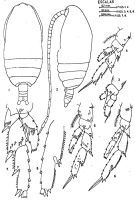 issued from : J. Corral Estrada in Tesis Doct., Univ. Madrid, A-129, Sec. Biologicas, 1970. [Lam.23]. Female (from Canarias Is.): 1, habitus (dorsal); 2, idem (lateral left side); 3, P1; 4, P2; 5, P3; 6, P4; 7, P2 (another specimen); 8, exopodal segment 3 of P4. Nota: Cephalothorax with hump dorsally. Outer edge of 2nd and 3rd of exopodal segments of P2 to P4 with a nuber of teeth variable: P2 (2nd with 2-8 teeeth; 3rd with 6-7 proximal and 5-6 distal); P3: (2nd with 7-11 teeth, 3rd with 8-10 proximal and 0 distal); P4 (2d with 11-14 proximal, 3rd with 15-19 proximal and 9-20 sistal). Left P5 with 4 sgments in 2 females on 71 examined (abnorlality).
|
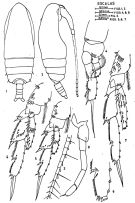 issued from : J. Corral Estrada in Tesis Doct., Univ. Madrid, A-129, Sec. Biologicas, 1970. [Lam.24]. Male: 1, habitus (dorsal); 2, idem (lateral right side); 3, distal segments of A1; 4, P1; 5, P2; 6, P3; 7, P4; 8, P5; 9, distal portion of the exopodal segment 3 of P4 (another specimen). Nota: The urosomal segments and furca in the proportional lengths 11-13: 25:12-17:13-14:18-20:15-17. Caudal rami divergent.
|
 issued from : T.E. Bowman in Bull. mar. Sc. Gulf Caribb., 1958, 8 (2). [p.119, Fig.1, B, C]. Female (from off Georgia, USA)): B, habitus (dorsal); C, idem (lateral). Nota: Cephalothorax about half as wide as long; with moderately developed dorsal hump. Nn partial suture between head and 1st thoracic segment. A1 reaching beyond caudal rami by about the last four segments.. Distal part of exopod segment 3 of P4 with 12-13 teeth on outer margin.
|
 issued from : T.E. Bowman in Bull. mar. Sc. Gulf Caribb., 1958, 8 (2). [p.119, Fig.1, A]. Female: A, A1.
|
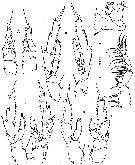 issued from : T.E. Bowman in Bull. mar. Sc. Gulf Caribb., 1958, 8 (2). [p.120, Fig.2]. Female: A, P1 (anterior surface on left, posterior surface on right); B, P4 (idem); C, P3 (idem); D, P2 (idem); E, Md; F, Mxp.
|
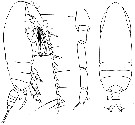 issued from : W. Vervoort in Atlantide Report., 1963, 7. [p.102, Fig.5]. Female (from off Ghana): a-b, habitus (lateral and dorsal, respectively) (x88); c, P5 (x375).
|
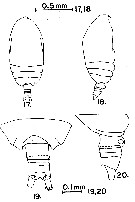 issued from : G.D. Grice in Fish. Bull. Fish and Wildl. Ser., 1962, 61. [p.185, Pl.5, Figs.17-20]. Female (from equatorial Pacific): 17-18, habitus (dorsal and lateral, respectively); 19-20, posterior part of thorax and urosome (dorsal and lateral, respectively). Nota: This species is recognized by the lack of partial suture between the head and 1st thoracic segment and the number of lateral teeth on the distal part of the 3rd exopodal segment of P4.
|
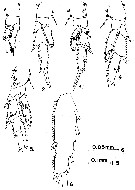 issued from : G.D. Grice in Fish. Bull. Fish and Wildl. Ser., 1962, 61. [p.186, Pl.6, Figs.1-6]. Female: 1, P1 (anterior); 2, P2 (anterior); 3, P2 (posterior); 4, P3 (anterior); 5, P3 (posterior); 6, 3rd exopodal segment of P4 (posterior).
| | | | | Compl. Ref.: | | | Neto & Paiva, 1966 (p.21, Table III); Bainbridge, 1972 (p.61, Appendix Table I: vertical distribution vs day/night); Corral Estrada & Pereiro Muñoz, 1974 (tab.I); Carter, 1977 (1978) (p.35); Dessier, 1979 (p.153, 201, 204); Vives, 1982 (p.290); Brenning, 1982 (p.4, Rem.); Dessier, 1983 (p.89, Tableau 1, Rem., %); Guangshan & Honglin, 1984 (p.118, tab.); Brenning, 1985 a (p.28, Table 2); Brinton & al., 1986 (p.228, Table 1); Lozano Soldevilla & al., 1988 (p.57); Suarez-Morales & Gasca, 1998 a (p.110); Lavaniegos & Gonzalez-Navarro, 1999 (p.239, Appx.1); Schnack-Schiel & al., 2010 (p.2064, Table 2: E Atlantic subtropical/tropical); Tutasi & al., 2011 (p.791, Table 2, abundance distribution vs La Niña event); Lidvanov & al., 2013 (p.290, Table 2, % composition); Palomares-Garcia & al., 2018 (p.178, Table 1: occurrence); | | | | NZ: | 11 | | |
|
Distribution map of Acrocalanus andersoni by geographical zones
|
| | | | | | | | | 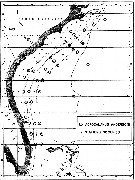 issued from : T.E. Bowman in Bull. mar. Sc. Gulf Caribb., 1958, 8 (2). [p.122, Fig.3]. issued from : T.E. Bowman in Bull. mar. Sc. Gulf Caribb., 1958, 8 (2). [p.122, Fig.3].
Distribution of A. andersoni, data for the 4 cruises combined. combined; T. N. Gill cruises 1-4 (10 Feb.-10 March, 17 April-14 May, 16 July-12 Aug., 17 Oct.-12 Nov.)
Nota: the species is an inhabitant of oceanic waters, and its shoreward distribution is limited by the cooler and less saline Carolinian Coastal water (Bumpus & Pierce, 1955). A. longicornis has a similar distribution, and the two species were often taken in the same net tow. |
| | | | Loc: | | | Angola (Baia Farta), Congo, G. of Guinea, Ivorian shelf, off S Cape Verde Is., off Senegal-Mauritania, Morocco-Mauritania, Canary Is., off Amazon, G. of Mexico, Florida, off S Cape Cod, Natal, Indian, Pacif. (equat.), Pacif. (W equatorial), China Seas (East China Sea, South China Sea), Japan Sea, G. of California, La Paz, Galapagos-Ecuador.
Data from Cornils & Blanco-Bercial (2013): 01°00'S; 09°00'W. | | | | N: | 37 | | | | Lg.: | | | (14) F: 1,12-1,02; M: 1,1; 0,99; (101) F: 1,17-0,95; (180) F: 1,29-1,09; M: 1,20-1,09; (332) F: 1,27; M: 1,12; (414) F: 1,3-1,15; (1112) F: 1,2; 1,3; {F: 0,95-1,30; M: 0,99-1,20} | | | | Rem.: | epipelagic.
For Bowman (1958, p.121) the species of Acrocalanus are most conveniently distinguished by the shape of the cephalothorax in lateral view. | | | Last update : 13/11/2020 | |
|
|
 Any use of this site for a publication will be mentioned with the following reference : Any use of this site for a publication will be mentioned with the following reference :
Razouls C., Desreumaux N., Kouwenberg J. and de Bovée F., 2005-2025. - Biodiversity of Marine Planktonic Copepods (morphology, geographical distribution and biological data). Sorbonne University, CNRS. Available at http://copepodes.obs-banyuls.fr/en [Accessed December 02, 2025] © copyright 2005-2025 Sorbonne University, CNRS
|
|
 |
 |












